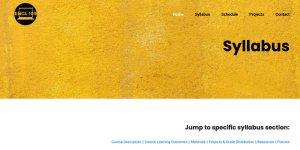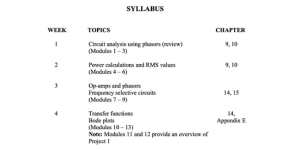
View an example of a web syllabus for ENGL 109, a core curriculum course.

This is a traditional PDF-style document for ECEN 100.

View the syllabus for an accelerated 3-week summer laboratory.
Designing an Effective Syllabus
Some instructors see the syllabus as a simple outline of the course topics, while others add everything related to the course as well as the kitchen sink. An effective syllabus lies somewhere in between. It should contain only the most important course-level information and link to other documents or resources related to broader topics—e.g., the program or campus—and narrower topics—e.g., detailed instructions for individual assignments or class activities. Importantly, your syllabus should be clear, easy to read, and engaging to your students. One idea is to create a syllabus that welcomes students to your community of learning.
Fundamental, course-level information can be broken down into a few categories:
| Category | Components |
|---|---|
| The facts |
|
| The goals |
|
| The path |
|
Process for Preparing an Effective Syllabus
- Look at example syllabi, such as the Visually Enhanced Syllabi listed on the UDL-Universe syllabus webpage and equity-minded syllabi included in the Center for Urban Education’s Syllabus Review Guide.
- Use strong learning outcomes as the nucleus of your syllabus.
- Create related documents separately, and link to them from your syllabus like a Wikipedia article.
- Provide a digital version of your syllabus and embed or link to short videos, screencasts or other media types.
- Create a graphic representation of learning outcomes: Create a concept map that shows the learning outcomes for your class, along with the different ways students will show they have reached them—i.e., related assessment strategies. This practice follows Universal Design for Learning principles of providing multiple pathways for students to succeed. To provide this concept map as a resource in your syllabus, you can use Microsoft SmartArt or concept mapping software to create the graphic
- representation of your learning outcomes (idea from Ayala & Christie, n.d.). NOTE: Linda Nilson (2007) also describes outcome maps in her book, The Graphic Syllabus and the Outcomes Map: Communicating Your Course.
Ensuring Student Engagement with the Syllabus
- Rather than simply going over the syllabus in class, start with a class activity related to the syllabus. Ask students to read through the syllabus in advance, or give them ten minutes to review it on the first day of class. Then engage them in a syllabus-related activity, such as the jigsaw activity outlined below.
- Try a syllabus jigsaw activity: To facilitate a jigsaw discussion activity about your syllabus, break the class into groups and assign responsibilities based on its different sections (e.g., become an expert on the facts, the goals, or the path). First, students work with peers who have the same responsibility to determine together what to share with their groups—e.g., what every student needs to know about that syllabus section. Then, students return to their groups and engage in discussions and/or take turns teaching their assigned material to the other students.
- Ask students to take a syllabus quiz to demonstrate they understand the expectations, how the course will run, etc.
Syllabus Statements
Santa Clara University provides suggestions for how you could communicate four important University matters that pertain to students in every class:
- Academic Integrity
- Office of Accessible Education (formerly Disabilities Resources)
- Accommodations for Pregnant and Parenting Students
- Discrimination and Sexual Misconduct (Title IX)
Course syllabi and course websites provide faculty members with ways to communicate course-specific information and selected University policies to students. All Santa Clara University syllabi must refer students to certain campus policies. These statements are required by the Provost’s Office, EEO and Title IX, and the Office of Accessible Education.
Additional Resources
Ayala, E. & Christie, B. (n.d.). Universal Design for Learning and Your Syllabus
Center for Urban Education. (2017). Syllabus review guide for equity-minded practice.
Iowa State University Center for Excellence in Teaching and Learning. (2017). Mindful and learner-centered syllabus checklist.
Nilson, L.B. (2007). The graphic syllabus and the outcomes map: Communicating your course. San Francisco: Jossey-Bass.
How to Create a Syllabus: Advice Guide Chronicle of Higher Education
Creating a Syllabus that Students Want to Read
Provost Office Teaching Expectations and Syllabus Standards
Page author:
Dr. Kevin Kelly, Lecturer at San Francisco State University
Last updated: March 12, 2024